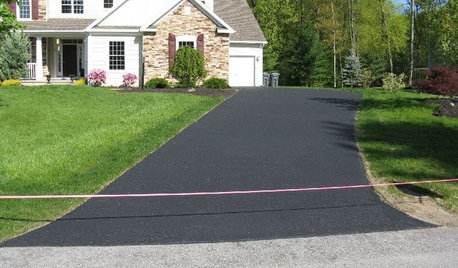stinky, sloppy mud
beckyinrichmond
11 years ago
Related Stories

LIFESimple Pleasures: Put On Your Slippers
Preserve the peace and protect your floors and carpets by turning your home into a no-shoes zone
Full Story
HOUSEKEEPING7-Day Plan: Get a Spotless, Beautifully Organized Living Room
A task a day sends messes away. Take a week to get your living room in shape
Full Story
MUDROOMSThe Cure for Houzz Envy: Mudroom Touches Anyone Can Do
Make a utilitarian mudroom snazzier and better organized with these cheap and easy ideas
Full Story
CURB APPEALHow to Reseal Your Asphalt Driveway
Protect your driveway and keep it looking great by applying new sealer every couple of years. Get the details here
Full Story
ENTRYWAYS8 Ideas for High-Functioning Mudrooms
Get more out of your mudroom with terrific storage, double-duty setups and clutter-hiding features
Full Story
UPHOLSTERYSlipcover Magic: Casual, Washable and Fresh for the Season
Reinvent your sofas, chairs and ottomans with surprisingly chic and versatile slipcovers
Full Story
LAUNDRY ROOMS7-Day Plan: Get a Spotless, Beautifully Organized Laundry Room
Get your laundry area in shape to make washday more pleasant and convenient
Full Story
FUN HOUZZ10 Truly Irritating Things Your Partner Does in the Kitchen
Dirty dishes, food scraps in the sink — will the madness ever stop?
Full Story
ORGANIZINGHow to Keep Your Home Neat When You Don't Have a Mudroom
Consider these 11 tips for tackling the clutter that's trying to take over your entry
Full Story
FURNITUREOld Furniture: Clean, Reupholster or Replace It?
A veteran upholstery cleaner weighs in on the options for found, inherited and thrift store furniture
Full StorySponsored
Custom Craftsmanship & Construction Solutions in Franklin County
More Discussions






nil13
Tiffany, purpleinopp Z8b Opp, AL
Related Professionals
Derry Landscape Architects & Landscape Designers · Marina Landscape Architects & Landscape Designers · Rancho Palos Verdes Landscape Architects & Landscape Designers · Framingham Landscape Contractors · Hickory Hills Landscape Contractors · Middle River Landscape Contractors · Pompton Lakes Landscape Contractors · Shoreview Landscape Contractors · West Haverstraw Landscape Contractors · Palos Heights Landscape Contractors · Lebanon Decks, Patios & Outdoor Enclosures · Meridian Decks, Patios & Outdoor Enclosures · Spokane Decks, Patios & Outdoor Enclosures · West Palm Beach Decks, Patios & Outdoor Enclosures · Decks, Patios & Outdoor Enclosuresnancyjane_gardener
Kimmsr
beckyinrichmondOriginal Author
nil13
nil13
beckyinrichmondOriginal Author
beckyinrichmondOriginal Author
mrcaballus
beckyinrichmondOriginal Author
luckygal
beckyinrichmondOriginal Author
beckyinrichmondOriginal Author
beckyinrichmondOriginal Author
beckyinrichmondOriginal Author
toxcrusadr
beckyinrichmondOriginal Author
nc_crn
beckyinrichmondOriginal Author
TXEB
toxcrusadr
Kuliani
TXEB
Tiffany, purpleinopp Z8b Opp, AL
Kuliani
TXEB
dobbyfran
duganboli
Greg Wilson
rgreen48
toxcrusadr